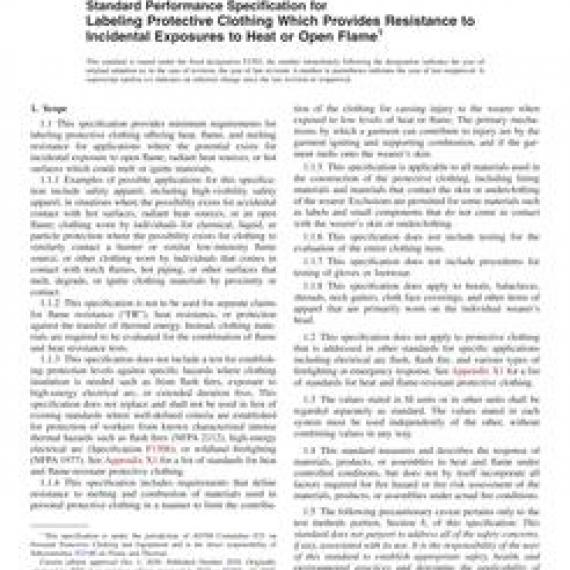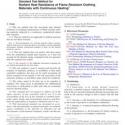No products
ASTM F2302-20
ASTM F2302-20 Standard Performance Specification for Labeling Protective Clothing Which Provides Resistance to Incidental Exposures to Heat or Open Flame
standard by ASTM International, 10/01/2020
Full Description
1.1This specification provides minimum requirements for labeling protective clothing offering heat, flame, and melting resistance for applications where the potential exists for incidental exposure to open flame, radiant heat sources, or hot surfaces which could melt or ignite materials.
1.1.1Examples of possible applications for this specification include safety apparel, including high-visibility safety apparel, in situations where the possibility exists for accidental contact with hot surfaces, radiant heat sources, or an open flame; clothing worn by individuals for chemical, liquid, or particle protection where the possibility exists for clothing to similarly contact a burner or similar low-intensity flame source; or other clothing worn by individuals that comes in contact with torch flames, hot piping, or other surfaces that melt, degrade, or ignite clothing materials by proximity or contact.
1.1.2This specification is not to be used for separate claims for flame resistance (FR), heat resistance, or protection against the transfer of thermal energy. Instead, clothing materials are required to be evaluated for the combination of flame and heat resistance tests.
1.1.3This specification does not include a test for establishing protection levels against specific hazards where clothing insulation is needed such as from flash fires, exposure to high-energy electrical arc, or extended duration fires. This specification does not replace and shall not be used in lieu of existing standards where well-defined criteria are established for protection of workers from known characterized intense thermal hazards such as flash fires (NFPA 2112), high-energy electrical arc (Specification F1506), or wildland firefighting (NFPA 1977). See Appendix X1 for a list of standards for heat and flame-resistant protective clothing.
1.1.4This specification includes requirements that define resistance to melting and combustion of materials used in personal protective clothing in a manner to limit the contribution of the clothing for causing injury to the wearer when exposed to low levels of heat or flame. The primary mechanisms by which a garment can contribute to injury are by the garment igniting and supporting combustion, and if the garment melts onto the wearers skin.
1.1.5This specification is applicable to all materials used in the construction of the protective clothing, including lining materials and materials that contact the skin or underclothing of the wearer. Exclusions are permitted for some materials such as labels and small components that do not come in contact with the wearers skin or underclothing.
1.1.6This specification does not include testing for the evaluation of the entire clothing item.
1.1.7This specification does not include procedures for testing of gloves or footwear.
1.1.8This specification does apply to hoods, balaclavas, shrouds, neck gaiters, cloth face coverings, and other items of apparel that are primarily worn on the individual wearers head.
1.2This specification does not apply to protective clothing that is addressed in other standards for specific applications including electrical arc flash, flash fire, and various types of firefighting or emergency response. See Appendix X1 for a list of standards for heat and flame-resistant protective clothing.
1.3The values stated in SI units or in other units shall be regarded separately as standard. The values stated in each system must be used independently of the other, without combining values in any way.
1.4This standard measures and describes the response of materials, products, or assemblies to heat and flame under controlled conditions, but does not by itself incorporate all factors required for fire hazard or fire risk assessment of the materials, products, or assemblies under actual fire conditions.
1.5The following precautionary caveat pertains only to the test methods portion, Section 8, of this specification: This standard does not purport to address all of the safety concerns, if any, associated with its use. It is the responsibility of the user of this standard to establish appropriate safety, health, and environmental practices and determine the applicability of regulatory limitations prior to use.
1.6This international standard was developed in accordance with internationally recognized principles on standardization established in the Decision on Principles for the Development of International Standards, Guides and Recommendations issued by the World Trade Organization Technical Barriers to Trade (TBT) Committee.


































